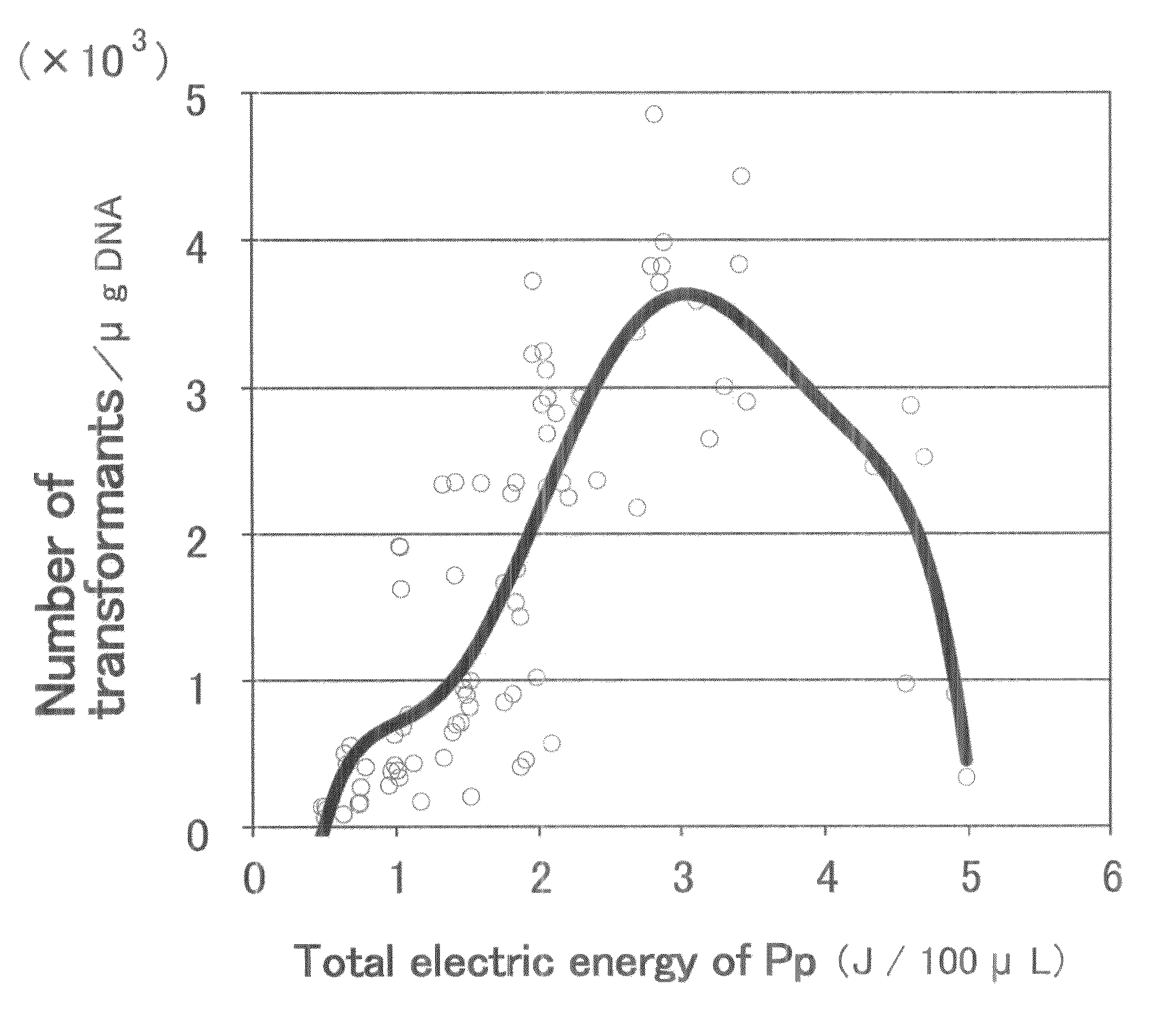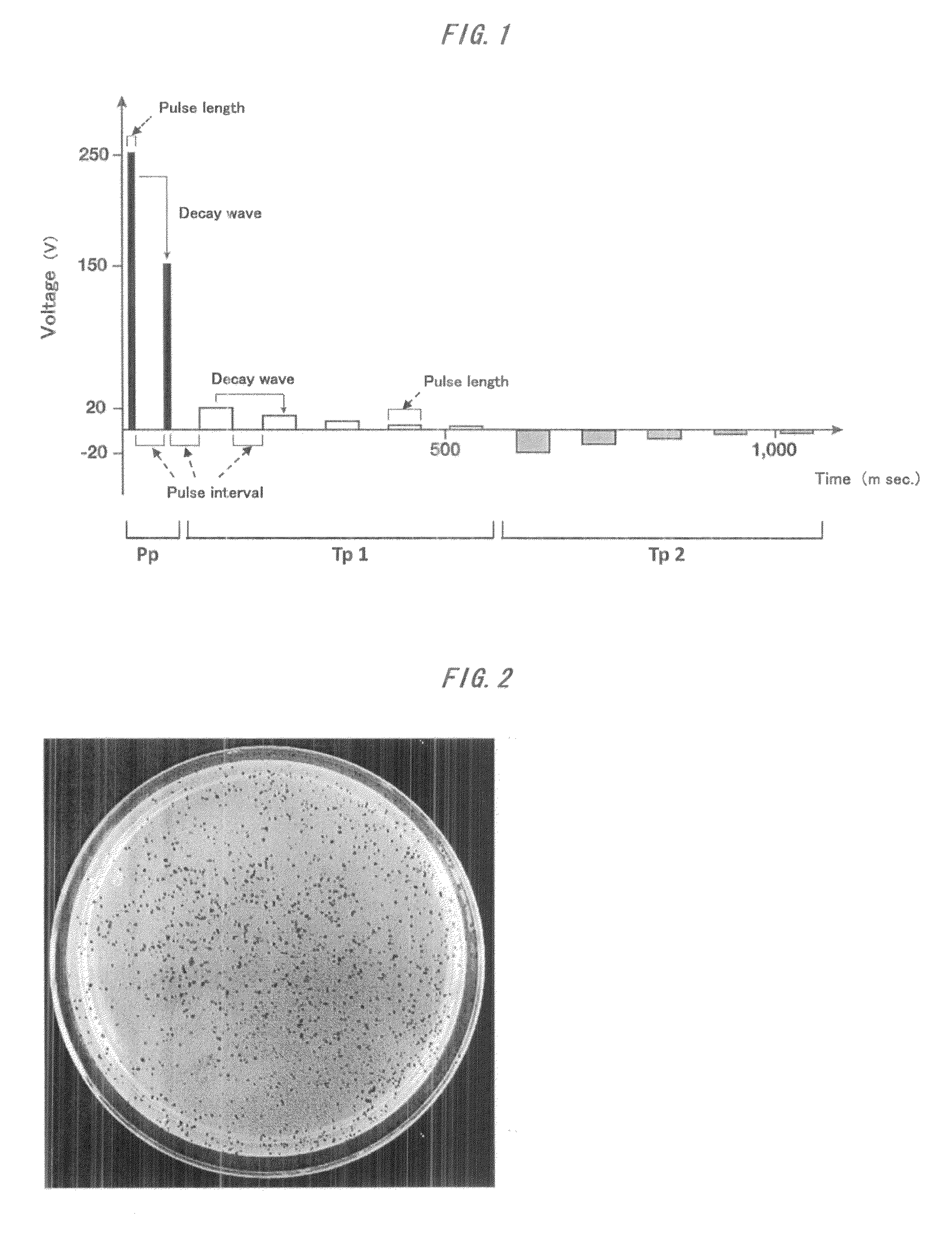Method of transferring gene into algal cell involving utilizing multiple square-wave pulses in three steps
a technology of transferring gene and algal cell, applied in the field of efficiently transferring gene into eukaryotic algal cell, can solve the problems of difficult in reality to use any of the three methods for most species of algae, low reproducibility depending on experimenters, and difficulty in realizing gene transfer and transformation, etc., and achieve good reproducibility and high efficiency
- Summary
- Abstract
- Description
- Claims
- Application Information
AI Technical Summary
Benefits of technology
Problems solved by technology
Method used
Image
Examples
example 1
“Electroporation Based on Square-Wave Three-Step Method”
[0144]A study was made of whether or not transformation of green algal cells still having cell walls based on an electroporation method using a cuvette electrode was able to be performed through the use of the square-wave three-step method.
[0145](1) “Preparation of Algal Cell Solution”
[0146]First, a study was made using, as a target, Chlamydomonas reinhardtii, a unicellular green alga easy to analyze for transformation.
[0147]300-mL conical flasks were previously subjected to dry-heat sterilization treatment, 100 mL each of a Tris-Acetate-Phosphate medium (TAP medium) were dispensed in the flasks, and 5 mL of a liquid culture medium of Chlamydomonas reinhardtii (Chlamydomonas reinhardtii strain C-9: strain NIES-2235 from National Institute for Environmental Studies) that had been precultured on a TAP medium were inoculated therein. While being agitated at 25° C. and 100 rpm under light illumination at 50 μmol / m2 / sec, culture was...
example 2
“Study of Voltage Value and Pulse Length of Poring Pulse”
[0163]Regarding the electric pulse conditions of the poring pulse, a study was made of the influences of the voltage value and the pulse length on the transformation efficiency.
[0164](1) “Electric Pulse Treatment”
[0165]In the same manner as in the method described in Example 1, a cell / DNA suspension (Chlamydomonas reinhardtii strain C-9: 1×108 cells / mL, about 2-kbp DNA fragment of pHyg3 containing aph7: 10 μg / mL) was prepared, and 40 μL of the suspension (4×106 cells / 40 μL, 400 ng / 40 μL) were charged into a 2-mm gap cuvette.
[0166]Square-wave electric pulse treatment based on the three-step method was performed by changing, for each prepared sample, the voltage of the poring pulse to 200 V (1,000 V / cm), 250 V (1,250 V / cm), or 300 V (1,500 V / cm), and further changing the pulse length to 2 ms, 4 ms, 6 ms, or 8 ms for each voltage condition. It should be noted that 6 samples were tested for each set of conditions (a total of 72 sa...
example 3
“Study of Electric Energy of Poring Pulse”
[0175]Regarding the electric pulse conditions of the poring pulse, a study was made of the influence of the electric energy on the transformation efficiency.
[0176](1) “Electric Pulse Treatment”
[0177]In the same manner as in the method described in Example 1, a cell / DNA suspension (Chlamydomonas reinhardtii strain C-9: 1×108 cells / mL, about 2-kbp DNA fragment of pHyg3 containing aph7: 10 μg / mL) was prepared, and 40 μL of the suspension (4×106 cells / 40 μL, 400 ng / 40 μL) were charged into a 2-mm gap cuvette.
[0178]Square-wave electric pulse treatment based on the three-step method was performed for a total of 84 samples by changing, for each prepared sample, the total electric energy (J / 100 μL) of the poring pulse within horizontal axis values shown in FIG. 4 (within the range of 0.5 to 5 J / 100 μL). It should be noted that various electric conditions were set within the ranges of values shown in Table 3. In addition, the equipment and basic oper...
PUM
| Property | Measurement | Unit |
|---|---|---|
| Length | aaaaa | aaaaa |
| Dielectric strength | aaaaa | aaaaa |
| Dielectric strength | aaaaa | aaaaa |
Abstract
Description
Claims
Application Information
 Login to View More
Login to View More - R&D
- Intellectual Property
- Life Sciences
- Materials
- Tech Scout
- Unparalleled Data Quality
- Higher Quality Content
- 60% Fewer Hallucinations
Browse by: Latest US Patents, China's latest patents, Technical Efficacy Thesaurus, Application Domain, Technology Topic, Popular Technical Reports.
© 2025 PatSnap. All rights reserved.Legal|Privacy policy|Modern Slavery Act Transparency Statement|Sitemap|About US| Contact US: help@patsnap.com



